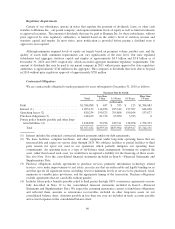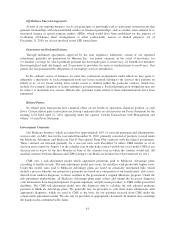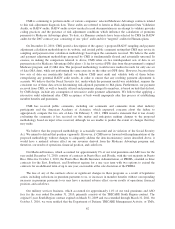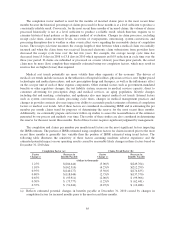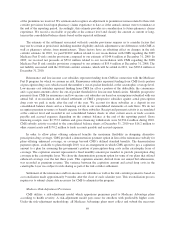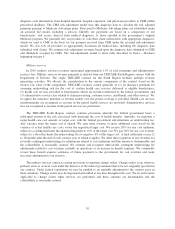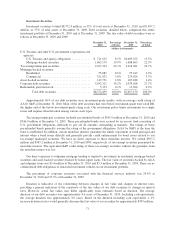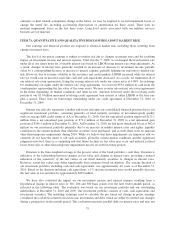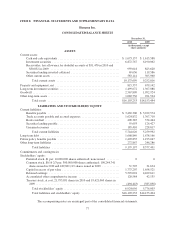Humana 2010 Annual Report Download - page 77
Download and view the complete annual report
Please find page 77 of the 2010 Humana annual report below. You can navigate through the pages in the report by either clicking on the pages listed below, or by using the keyword search tool below to find specific information within the annual report.
improvements resulted in recoveries from the identification of claims billed at higher cost codes than those
documented in the medical records via audits, as well as an improved ability to collect overpayments due to the
development of system enhancements to our Commercial claims processing platform. We believe we have
consistently applied our methodology in determining our best estimate for benefits payable.
We continually adjust our historical trend and completion factor experience with our knowledge of recent
events that may impact current trends and completion factors when establishing our reserves. Because our
reserving practice is to consistently recognize the actuarial best point estimate using an assumption of moderately
adverse conditions as required by actuarial standards, there is a reasonable possibility that variances between
actual trend and completion factors and those assumed in our December 31, 2010 estimates would fall towards
the middle of the ranges previously presented in our sensitivity table.
Benefit expenses associated with military services and provisions associated with future policy benefits
excluded from the previous table were as follows for the years ended December 31, 2010, 2009 and 2008:
2010 2009 2008
(in thousands)
Military services ................................. $3,059,492 $3,019,655 $2,819,787
Future policy benefits ............................. 305,875 73,130 64,338
Total ...................................... $3,365,367 $3,092,785 $2,884,125
Our TRICARE contract contains provisions whereby the federal government bears a substantial portion of
the risk of financing health benefits. The federal government both reimburses us for our cost of providing health
benefits and bears responsibility for 80% of any variance from the annual target health care cost and actual health
care cost as more fully described beginning on page 70. Therefore, the impact on our income from operations
from changes in estimate for TRICARE benefits payable is reduced substantially by corresponding adjustments
to revenues. The net decrease to income from operations as determined retrospectively, after giving consideration
to claim development occurring in the current period, was approximately $9.4 million for 2009 and $7.8 million
for 2008. The impact from changes in estimates for 2010 is not yet determinable as the amount of prior period
development recorded in 2011 will change as our December 31, 2010 benefits payable estimate develops
throughout 2011.
Future policy benefits payable of $1,492.9 million and $1,193.0 million at December 31, 2010 and 2009,
respectively, represent liabilities for long-duration insurance policies including long-term care, health, and life
insurance policies and annuities sold to individuals for which some of the premium received in the earlier years is
intended to pay anticipated benefits to be incurred in future years. These reserves are recognized on a net level
premium method based on interest rates, mortality, morbidity, withdrawal and maintenance expense assumptions
from published actuarial tables, modified based upon actual experience. The assumptions used to determine the
liability for future policy benefits are established and locked in at the time each contract is acquired and would
only change if our expected future experience deteriorated to the point that the level of the liability, together with
the present value of future gross premiums, are not adequate to provide for future expected policy benefits.
Future policy benefits payable include $824.6 million at December 31, 2010 and $571.9 million at December 31,
2009 associated with a closed block of long-term care policies acquired in connection with the November 30,
2007 KMG acquisition. Long-term care policies provide for long-duration coverage and, therefore, our actual
claims experience will emerge many years after assumptions have been established. The risk of a deviation of the
actual morbidity and mortality rates from those assumed in our reserves are particularly significant to our closed
block of long-term care policies. We monitor the loss experience of these long-term care policies and, when
necessary, apply for premium rate increases through a regulatory filing and approval process in the jurisdictions
in which such products were sold. To the extent premium rate increases and/or loss experience vary from our
acquisition date assumptions, future adjustments to reserves could be required. During the fourth quarter of 2010,
certain states approved premium rate increases for a large portion of our long-term care block that were
significantly below our acquisition date assumptions. Based on these actions by the states, combined with lower
67





